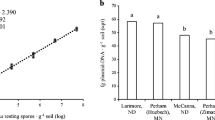Abstract
Two studies were conducted to determine the effect of systemic pesticides on the potato tuber total glycoalkaloid (TGA) content at harvest. In a field study, a pretuberization application of three systemic insecticides (disulfoton, aldicarb, carbofuran) and three systemic fungicides (thiabendazole, benomyl, thiophanate methyl) on three potato cultivars (Cobbler, Katahdin and B5141-6) showed carbofuran to be the only treatment significantly different (P= .05) from the control. The tuber TGA content of the carbofuran treatment was lower than that of the control. In a greenhouse study, carbofuran applied during tuberization to three potato varieties (Norland, Kennebec, Abnaki) produced a highly significant increase (P= .01) in the tuber TGA content. A significant varietal difference (P=.01) in response to the carbofuran treatment was also evidenced.
Resumen
Dos estudios fueron Ilevados a cabo para determinar el efecto de pesticidas sistémicos sobre el contenido total de glicoalkaloides (GAT) a la cosecha. En un estudio de campo, una aplicación, previa a la tuberización, de tres insecticidas sistémicos (disulfoton, aldicarb, carbofuran) y tres fungicidas sistémicos (thiabendazole, benomyl, methil thiophanate) sobre tres cultivares de papa (Cobbler, Kathodin y B5141-6) indicaron que carbofuran resultó ser el único tratamiento significativamente diferente (P=0.05) al control. El contenido de GAT en los tubérculos provenientes del tratamiento con carbofuran fue inferior que el de control. En un estudio de campo, el carbofuran aplicado durante la tuberización a tres variedades de papa (Norland, Kennebec, Abnaki) produjo un incremento altamente significativo (P=0.01) en el contenido de GAT del tubérculo. Una diferencia varietal significativa (P=0.01) en respuesta al tratamiento de carbofuran se hizo igualmente evidente.
Similar content being viewed by others
Literature Cited
Allen, E. H., and J. Kuć. 1968. Solanine and chaconine as fungitoxic compounds in extracts of Irish potato tubers. Phytopath. 58: 776–781.
Bömer, A., and H. Mattis. 1924. Der solaningehalt der Kartoffeln. Z. Untersuchung, Nahr. -u. Genussmtl. 47: 97–127.
Dahlman, D. L. and E. T. Hibbs. 1967. Response ofEmpoasca fabae to tomatine,solanine, leptine 1, tomatidine, solanidine, and demissidine, Ann. Entomol. Soc. Amer 60: 732–740.
Kuhn, R. and I. Low. 1955. Chaconine. Annales Acad. Sci. Fennicae, Ser. A., 11, 488–495.
Locci, R. and J. Kuć. 1967. Steroid alkaloids as compounds produced by potato tubers under stress. Phytopath. 57: 1272–1273.
McKee, R. K. 1969. Factors affecting the toxicity of solanine and related alkaloids toFusarium caeruleum. J. Gen. Microbiol. 20: 686–696.
Ozeretskovskaya, O. L., M. A. Davydova, N. I. Vasyukova, and L. V. Metlitskii. 1971. Glycoalkaloids in healthy and damaged potato tubers. Doklady Akademii Nauk SSSR. Bot. Sci. Sec. 196: 1470–1473.
Pierzchalski, T. 1957. Changes in glycoalkaloid content in leaves of cultivated and wild potatoes and their hybrids during growth and their influence on the Colorado potato beetleLeptinotarsa decemlineata Say). Hodowla Roslin, Aklimatyzacja I. Nasiennictwo. 1: 415:430.
Poswillo, D. E. 1971. Experimental induction of foetal malformation with “blighted” potato: a preliminary report. Nature 239: 462–464.
Reilly, J. J. and W. L. Klarman. 1972. The soybean phytoalexin, hydroxyphaseollin, induced by fungicides. Phytopath. 62: 1113–1115.
Renwick, J. H. 1972. Hypothesis: anecephaly and spina bifida are usually preventable by avoidance of a specific but unidentified substance present in certain potato tubers. British J. Preventative and Social Med. 26: 67–88.
Schreiber, K. 1957. Naturally occurring plant resistance factors against the Colorado potato beetle (Leptinotarsa decemlineata) and their possible mode of action. Zuchter 27: 289–299.
Sinden, S. L., R. G. Goth and M. J. O’Brien. 1973. Effect of potato alkaloids on the growth asAlternaria solani and their possible role as resistance factors in potatoes. Phytopath. 63: 303–317.
Sinden, S. L., and R. E. Webb, 1974. Effect of environment on glycoalkaloid content of six potato varieties at 39 locations. ARS, USDA Bull. 1472.
Stürckow, B.,and I. Löw. 1961. The effects of some Solanum alkaloid glycosides on the potato beetle. Entomol. Exp. Appl. 4: 133–142.
Willimott, S. G. 1933. An investigation of solanine poisoning. Analyst 58: 431–438.
Author information
Authors and Affiliations
Additional information
Mention of a trademark or proprietary product does not constitute a guarantee or warranty of the product by the U.S. Department of Agriculture and does not imply its approval to the exclusion of other products that may also be suitable.
Rights and permissions
About this article
Cite this article
Wilson, J.M., Frank, J.S. The effect of systemic pesticides on total glycoalkaloid content of potato tubers at harvest. Am. J. Pot Res 52, 179–184 (1975). https://doi.org/10.1007/BF02838109
Received:
Issue Date:
DOI: https://doi.org/10.1007/BF02838109




